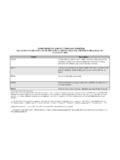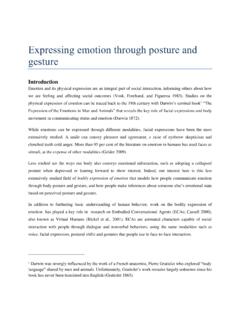Transcription of Interpersonal Communication - LU
1 Interpersonal Communication How do people communicate with each other in their face-to-face meetings and conversations? Do we really under-stand all the Interpersonal codes and signals which we use and react to? Interpersonal Communication provides a comprehensive introduction for students of the how and why of Interpersonal Communication . Peter Hartley uses research and theory from Social Psychology, Sociology, and Linguistics to provide a framework for understanding how we use language, gestures and facial expressions to communicate. The book is divided into three parts. Part one outlines the main concepts necessary to understand both the skills and the process of Interpersonal Communication ; part two looks at these processes in more detail and discusses their everyday applications and implications. For example, what evidence is there to support the claim that our gestures and facial expressions reveal to others what we 'really' mean?
2 Can we trust our first impressions of people, or should we be more cautious? Part three examines situ-ations - for example, interaction between groups of people - where 'more than Interpersonal ' Communication is involved. Interpersonal Communication will be an invaluable resource for students and teachers of A-level and undergraduate courses in Communication Studies and Social Sciences, and also to anyone who would like to know more about how we communicate. Peter Hartley is Head of Academic Development in the School of Cultural Studies, Sheffield Hallam University. Interpersonal Communication Peter Hartley London and New York First published 1993 by Routledge 11 New Fetter Lane, London EC4P 4EE Simultaneously published in the USA and Canada by Routledge 29 West 35th Street, New York, NY 10001 Reprinted 1995, 1996 Routledge is an International Thomson Publishing company 1993 Peter Hartley Printed and bound in Great Britain by T.
3 J. Press (Padstow) Ltd, Padstow, Cornwall All rights reserved. No part of this book may be reprinted or reproduced or utilized in any form or by any electronic, mechanical, or other means, now known or hereafter invented, including photocopying and recording, or in any information storage or retrieval system, without permission in writing from the publishers. British Library Cataloguing in Publication Data A catalogue record for this book is available from the British Library Library of Congress Cataloguing in Publication Data A catalogue record for this book is available from the Library of Congress ISBN 0-415-01385-2 (pbk) Contents Acknowledgements vi Foreword vii Section A: Deciding what we mean by Interpersonal Communication 1 Defining Interpersonal Communication 1 2 The process of Interpersonal Communication 17 3 The skills of Interpersonal Communication 33 4 Communication skills in context 57 Section B.
4 Understanding the components of Interpersonal Communication 5 The social context 79 6 Social identity 107 7 Social perception 127 8 Codes 149 Section C: Moving beyond the Interpersonal 9 Communication and groups 173 10 Looking back and forward 203 Index 213 V Acknowledgements Thanks are due to many people who helped in developing this book. Needless to say I am responsible for any flaws in the final version. Special thanks go to: Guy Fielding, who collaborated on the initial outline Andrew Beck, Gary Radford, and Jane Weston, who commented on various drafts Julia, James and David, who provided various combinations of inspiration and practical help Jane Armstrong and Rebecca Barden, for their patience and encouragement well beyond the call of duty vi Foreword Introductions to textbooks can range from a brief paragraph to mini-novels which tell you almost everything which is in the rest of the book.
5 Avoiding these extremes, I have simply tried to answer a few questions which may help you decide whether you actually want to read any further. What are the aims of this book? The main aim is to provide a basic introductory text on Interpersonal Communication , ie face-to-face communica-tion between two people. So I have tried to: explain the special or distinctive characteristics of Interpersonal Communication identify the component parts of Interpersonal Communication explain how these components relate to one another explain the most important features of the skills involved in communicating with other people contrast the characteristics of Interpersonal Communication with other forms of communi cation Although the main concepts and theories are drawn from research in the social sciences, I have tried to avoid social science jargon unless it really helps to express the argu-ments.
6 My aim was to make this text readable and interest-ing. How is the book organised? The major sections In section A, I try to establish a coherent framework for understanding Interpersonal Communication . As well as vii Interpersonal Communication offering a definition and model of the process, I discuss the major skills involved and show how these different ap-proaches to the subject are related. Section B provides a more detailed analysis of the major components of Interpersonal Communication . Section C introduces situations which involve other people but where there are processes over and above the ones outlined in section B. For example, Communication in groups is not the same as communicating with one other person - there are different influences at work. Within chapters Each chapter is sub-divided into major sections which are listed at the beginning of each chapter.
7 Each major section focusses on one important question or issue. At the end of each chapter, there is a list of notes which includes: details of references cited in the text further comments for anyone wishing to ex plore the topic in more detail references and suggestions for further reading. What is the best way to read this book? This may seem a nonsensical question. Surely you simply read any book from beginning to end. I disagree. That may be the way to read a novel on a train journey but is not the way we read many books. This text will be read by different people for different purposes and so you may wish to choose a different approach. For example: If you are reading this simply from general interest in the topic, then I suggest that you read Chapters 1 and 2 fairly quickly concentrate on the aspects that interest you in the remaining chapters viii Foreword ignore the notes unless anything strikes you as particularly interesting If you are reading this as a student on a course, then I suggest that you read Section A first read subsequent chapters in the order in which they crop up in your course when you read a chapter you skim-read it first before going through it more slowly and check ing the notes Whatever your approach, I hope you find this book helpful and interesting.
8 And that you find some ideas which you can use to make your own Communication more satisfying and effective. Language and sexism In my own teaching, I warn students to avoid sexist lan-guage and expressions. So I have tried to practise what I preach. In this book, "he" is always male and "she" is always female, except in a few of the direct quotes from other authors who have obviously not read Miller and Swift. Peter Hartley October 1992 Notes 1 Anyone who is not convinced that sexist language should be avoided both for the sake of accuracy and fairness is referred to this excellent book: C. Miller and K. Swift (1989) The Handbook of Non-Sexist Writing, 2nd edn, The Women's Press ix Section A Deciding what we mean by Interpersonal Communication 1 Defining Interpersonal Communication In this chapter, I shall: introduce the definition of Interpersonal Communication which is used throughout this book outline a number of propositions about Interpersonal Communication which can be developed from this definition and which have important practical and theoretical implications 1 Interpersonal Communication How can we define Interpersonal Communication ?
9 Most books which can be used as textbooks start with a chapter which tries to define the subject matter and ap-proach. This is an obvious place to start if you are completely new to the subject. But what about a text on Communication ? Surely we all know what Communication is? Isn't it a major part of all our daily lives? One writer has gone so far as to say that:1 all social interaction is necessarily communicative and any social process presumes a Communication process In other words, anything we do with other people must involve Communication . If Communication is so "universal", then perhaps I can assume that everyone knows what it is, and move straight on to the next chapter! Unfortunately, things are not so straightforward. If you read a number of textbooks on com-munication, you will find a variety of definitions which emphasise different things.
10 You will also find considerable practical differences in everyday life. Some people seem to regard the essence of Communication as "being able to speak and write proper English" whereas others would argue that "good communicators are good listeners". So it is important to clarify what I am talking about. To return to the academic debate, I can easily produce a list of fifteen general definitions of Communication which represent rather different ideas or emphases!2 A similar variety of definitions also exists for Interpersonal communi -cation. As well as verbal definitions, there are many models of Interpersonal Communication , often expressed as diag-rams involving numerous boxes and In this book, I have attempted to synthesise as many of these ideas as possible to highlight the fundamental processes. 2 Defining Interpersonal Communication I can best introduce my approach by comparing events which obviously involve people communicating with one another in different contexts.











